"I'm not sure who thought it was a good idea to put up CubeSats with Artemis I."
NASA officials sounded an alarm Tuesday about the agency's Deep Space Network, a collection of antennas in California, Spain, and Australia used to maintain contact with missions scattered across the Solar System.
Everything from NASA's Artemis missions to the Moon to the Voyager probes in interstellar space rely on the Deep Space Network (DSN) to receive commands and transmit data back to Earth. Suzanne Dodd, who oversees the DSN in her position at NASA's Jet Propulsion Laboratory, likes to highlight the network's importance by showing gorgeous images from missions like the James Webb Space Telescope and the Perseverance rover on Mars.
"All these images, and all these great visuals for the public, and all the science for the scientists come down through the Deep Space Network," Dodd said Tuesday in a meeting of the NASA Advisory Council's Science Committee.
DSN is in deep sh!#
But Dodd doesn't take a starry-eyed view of the challenges operating the Deep Space Network. She said there are currently around 40 missions that rely on the DSN's antennas to stay in communication with controllers and scientists back on Earth. Another 40-plus missions will join the roster over the next decade or so, and many of the 40 missions currently using time on the network will likely still be operating over that time.
"We have more missions coming than we currently are flying," Dodd said. "We’re nearly doubling the load on the DSN. A lot of those are either lunar exploration or Artemis missions, and a lot of Artemis precursor missions with commercial vendors. So the load is increasing, and it’s very stressful to us.”
“It’s oversubscribed, yet it’s vital to anything the agency wants to do," she said.
Vint Cerf, an Internet pioneer who is now an executive at Google, sits on the committee Dodd met with Tuesday. After hearing from Dodd and other NASA managers, Cerf said: "The deep space communications system is in deep—well, let me use a better word, deficit. There’s a four-letter word that occurs to me, too."
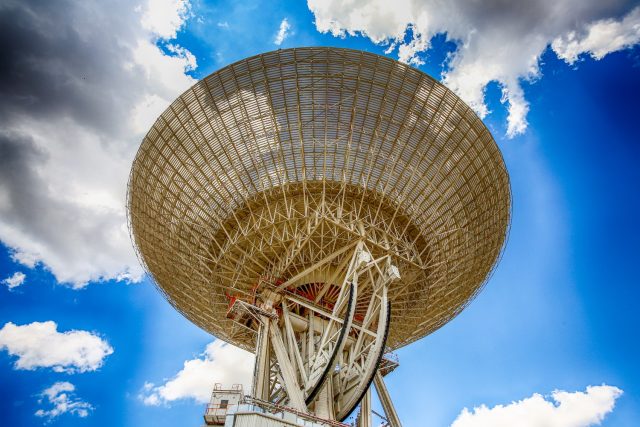
An antenna at NASA's Deep Space Network station near Madrid.
Ricardo Rubio/Europa Press via Getty Images
Because astronauts are involved, the Artemis missions will come with unique requirements on the DSN.
"We're not going to have bits of data. We're going to have gigabits of data," said Philip Baldwin, acting director of the network services division at JPL. "I don't want 1080p for video resolution. I want 8K video."
Each of the three stations on the Deep Space Network has a 70-meter (230-foot) dish antenna, the largest antennas in the world for deep space communications. Each location also has at least three 112-foot (34-meter) antennas. The oldest of the large antennas in California entered service in 1966, then was enlarged to its 70-meter diameter in 1988.
“We have reached a really critical point on the DSN’s aging infrastructure," said Sandra Cauffman, deputy director of NASA's astrophysics division.
Artemis I case study
Dodd presented some numbers from late last year to highlight the problem. During the Artemis I mission, NASA's Orion spacecraft spent about 25 days traveling from Earth to a distant orbit around the Moon, then returned to a splashdown in the Pacific Ocean. The Deep Space Network's antennas collectively spent 903 hours tracking and communicating with the Orion spacecraft during Artemis I.
But there's more to the story. There were 10 small rideshare secondary payloads that flew into deep space on the Space Launch System rocket on Artemis I. These CubeSats ranged in size from a shoebox to a briefcase, with small antennas and low-power transmitters that required large antennas on Earth to make a reliable connection.
Eight of these CubeSats were tracked with the DSN, according to Dodd. "They got 871 hours of tracking, nearly as much as Artemis for eight little CubeSats," she said.
"I'm not sure who thought it was a good idea to put up (so many) CubeSats with Artemis I," Dodd said.
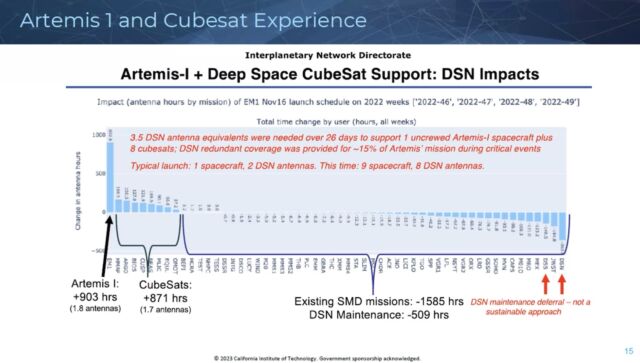
This chart shows usage of the Deep Space Network (in hours) during the Artemis I mission in late
2022, illustrating the time devoted to the Orion spacecraft and the CubeSat secondary payloads.
NASA
With limited resources and only so many antennas to go around, the Deep Space Network had to turn away from NASA's other science missions to focus on the Orion spacecraft and the CubeSats flying along with it.
“The missions that lost the most include James Webb, your flagship mission, 184 hours they gave up to support Artemis and CubeSats," Dodd said. The DSN also deferred more than 500 hours of planned maintenance time during Artemis I.
That translates to potential lost or delayed scientific results from the $10 billion James Webb Space Telescope. Other missions that gave up more than 100 hours of time on the DSN during Artemis I included the Mars Reconnaissance Orbiter, the Mars Odyssey mission, and Europe's Mars Express.
“When Artemis comes online, everybody else moves out of the way, and it’s an impact to all the science missions, even the flagship science missions," Dodd said.
Small satellites like CubeSats are common in low-Earth orbit, providing commercial remote sensing and data relay services, along with offering researchers an opportunity to perform experiments at much lower cost than if they flew on a larger spacecraft. NASA wants to use CubeSats more in deep space exploration for missions to the Moon, Mars, and asteroids.
What makes CubeSats appealing to NASA and research scientists is what makes them unappealing to the Deep Space Network, Dodd said.
"They're quick, they're not well-tested. They use little antennas," she said. "When they get in trouble, they need a really big antenna to find them... Do you want these CubeSats to take as much time (on the DSN) as James Webb?"
Most of the rideshare payloads on Artemis I encountered trouble after deploying from their dispensers on the SLS rocket, and some were never heard from after the launch. This took time on the DSN antennas to attempt to locate and restore communication with the CubeSats. The network's largest antennas are often used to communicate with spacecraft experiencing emergencies.
"When your DSN is oversubscribed, I don't think it's a good use to put throwaway missions on the same set of antennas. Throwaway is probably not polite... They have a place. But their place, in my mind, is really not on the DSN, at least not in these numbers. Half of these missions were probably dead before they even launched out of the ring because of the design."
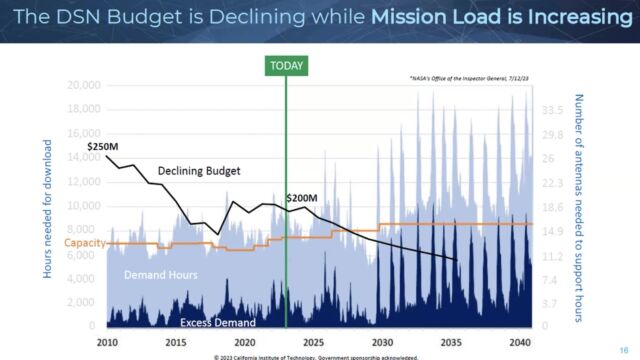
This chart shows increasing demand on the Deep Space Network from science, commercial, and Artemis missions. The spikes in activity represent Artemis missions to the Moon.
NASA
"CubeSats are often advertised as being this panacea for all of our future science," said Sara Tucker, a consultant at Ball Aerospace and a member of the committee that heard from NASA officials Tuesday. "They're cheap. They're easy. We can throw them up. If they don't work, we'll just throw up more. But it is clearly presenting a non-negligible burden here.”
NASA hasn't made a final decision on whether the next Artemis mission, Artemis II, will have any CubeSats aboard. Artemis II is set for launch in late 2024 or 2025 with four astronauts who will fly around the far side of the Moon inside their Orion capsule. NASA is planning to accommodate CubeSats on later Artemis missions.
Later this decade, NASA will call upon the DSN to support not just the Orion crew spacecraft traveling to and from the Moon on Artemis missions, but also the Gateway mini-space station the agency plans to build in lunar orbit. Commercial human-rated Moon landers from SpaceX and Blue Origin, along with commercial robotic landing vehicles, will also rely on the DSN for connectivity with Earth. Just last week, the DSN was in communication with India's Chandrayaan 3 lander as it descended to the lunar surface.
Dodd said NASA managers overseeing the commercial lunar mission contracts are "really committing the DSN asset without asking, 'What does the loading do to everybody else?'"
“I don't know how it's all going to play together," Dodd said. "But right now, it looks a bit like a mess. Looking at this chart and looking out in the 2030s, that really scares us."
What’s being done?
This isn't the first time NASA officials have talked about the challenges facing the Deep Space Network, but the discussion with NASA advisers Tuesday presented the problem with renewed urgency.
“There are a dozen studies that go back 10 years that basically say the same thing as far as the DSN infrastructure is decaying, (and) funding needs to be provided for succession planning," Dodd said. “Did those reports work? I think they raised the issues and people acknowledged the issues, but from where I sit, we do not see action happening at the agency level.”
NASA's inspector general last month found that demand on the DSN sometimes exceeds supply by as much as 40 percent. Limitations in capacity have "already impacted agency missions' ability to fully meet objectives and achieve full return on investment," the inspector general wrote in an audit of the DSN.
"As crewed Artemis missions come online and receive priority over uncrewed missions such as the JWST and Mars 2020 Perseverance Rover, missions will be challenged to schedule DSN time and may not receive the full amount of capacity they require for timely navigation and data transfer," the inspector general wrote.
The agency's internal watchdog said a project to upgrade the three DSN sites with more 34-meter antennas and higher-power transmitters is five years behind schedule, and the cost of the upgrades has increased to $706 million. That expense takes a long time to pay off for the DSN's budget account, which has fallen from an annual level of about $250 million in 2010 to about $200 million today.
NASA originally planned to replace the 70-meter antennas with an array of newer 34-meter antennas at each DSN station, but the agency has decided to keep the aging 70-meter dishes operating, according to the inspector general's report.
"When you're looking for infrastructure, it's hard to convince anybody to support infrastructure funding versus a cool vehicle to go to the Moon," Baldwin said.
About $45 million in additional funding per year could allow the DSN team to bolster the network's infrastructure and hire more staff to provide 24-hour support at all three stations, according to Dodd. Some older antennas could also be brought back into service to meet the increasing demand, she said.
“If we want to get DSN back to a reliable future, we need to recover from these years of decline," Dodd said. She added that astronauts could be endangered if the DSN goes offline during an Artemis mission to the Moon.
After making these proposals to NASA leadership, "the number coming back is zero," Dodd said. "I think we could definitely use some advocacy within the agency."
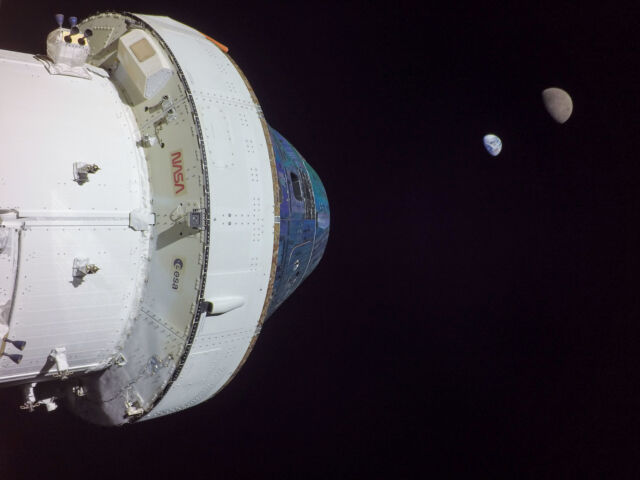
This view of the Earth and the Moon was captured by a camera on NASA's Orion spacecraft on
the Artemis I mission and was then transmitted to the Deep Space Network.
NASA
The NASA inspector general recommended the agency explore more efficient options for scheduling time on the Deep Space Network, such as maintaining a list of priority missions that is widely accessible.
“During Artemis (missions), the simple priorities are Artemis, and then James Webb, and maybe then the CubeSats, something like that," Dodd said. "But you also have to factor in the maintenance. The DSN maintenance has to be a priority.”
NASA is in the early stages of planning a new network of communications stations around the world dedicated to lunar missions, which often don't require the largest antennas on the DSN. These new antennas won't be operational until 2027 and won't solve the whole problem facing the Deep Space Network, which will still support Artemis missions, NASA's inspector general said.
One longer-term solution may be laser communications, which would not use the DSN at all. NASA will launch a laser communications package with the Psyche asteroid mission in October to demonstrate long-range optical data transmissions from the asteroid belt.
The space agency also plans to purchase data relay services from commercial satellites that companies plan to deploy around the Moon. These relay satellites will be particularly useful for missions to the south pole and far side of the Moon, where direct-to-Earth data links are partially or completely blocked.
NASA relies on commercial ground stations for more than half of its ground station support for the agency's satellites in low-Earth orbit. NASA last year selected SpaceX, Amazon, Viasat, Telecast, SES, and Inmarsat to begin developing commercial capabilities to replace the government-owned Tracking and Data Relay Satellite network, which is used for near-continuous connectivity with the International Space Station and other satellites closer to Earth.
But NASA says there's no commercial alternative to the DSN's largest antennas.
"One thing about the Deep Space Network is it’s not like what exists in the commercial market," Baldwin said. "Often there’s confusion about what the industry is able to do versus what the DSN can support. What DSN does is very unique, and (there's) not an easy analogy to what’s available in the commercial market.”
Source



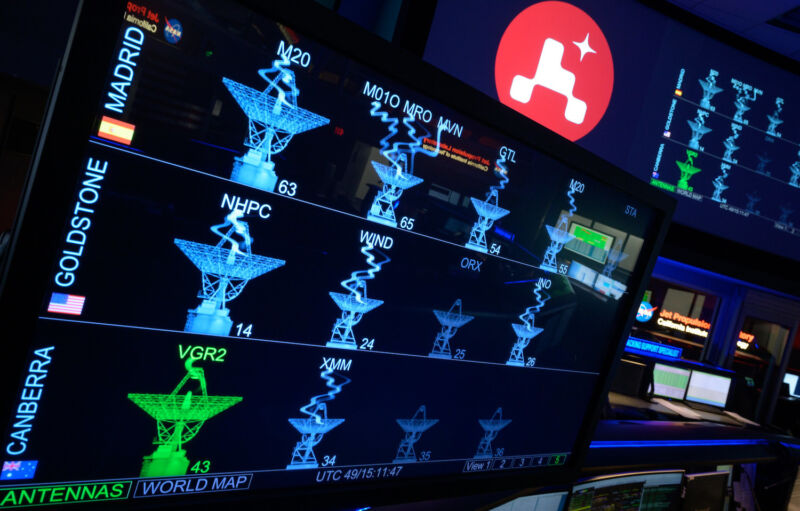
3175x175(CURRENT).thumb.jpg.b05acc060982b36f5891ba728e6d953c.jpg)




Recommended Comments
There are no comments to display.
Join the conversation
You can post now and register later. If you have an account, sign in now to post with your account.
Note: Your post will require moderator approval before it will be visible.